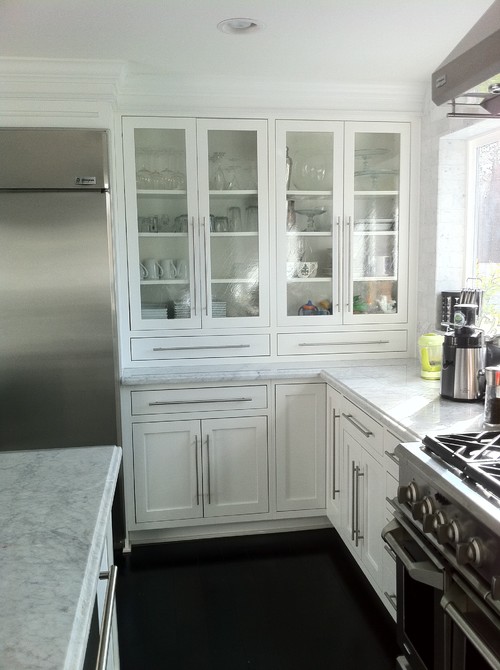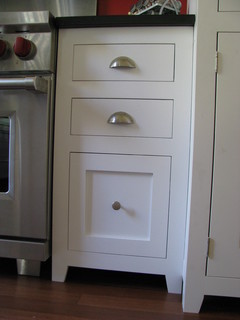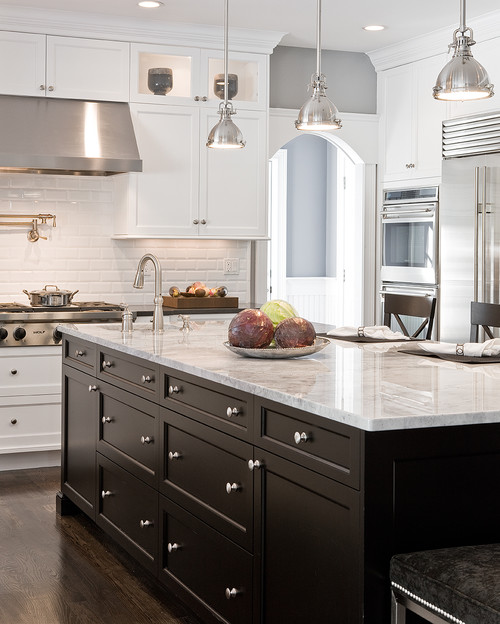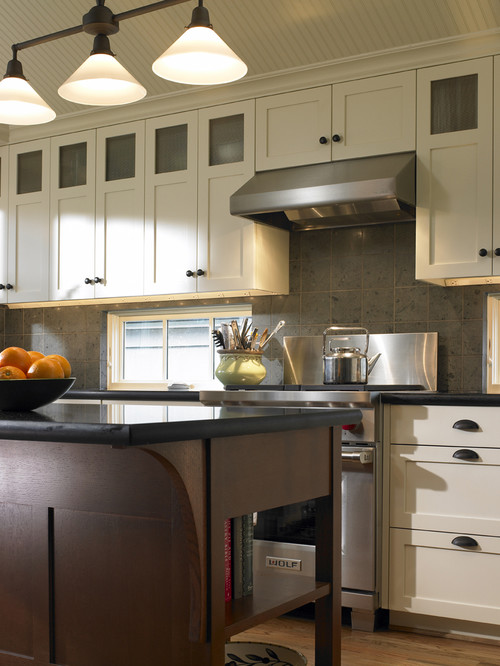Before you start your search for a new kitchen or bathroom designer, it's helpful to anticipate a few of their questions. One of the biggest decisions you'll make (other than overall aesthetic, door style, and color) is what type of construction you desire.
There are three basic types: Inset, Overlay, and Frameless.
Each fits a different need and aesthetic. The difference between them all is how the door relates to the front frame of the cabinet. Don't worry, there will be pictures!
INSET
Inset Cabinetry fits a more traditional style. It's often used in cottage or craftsman style homes, but can be made more intricate or simple by your choice of door style.
The term "inset" refers to the construction. The door is inset within (and flush to) the face frame of the cabinet.
Choosing inset cabinetry creates a clean, classic look. It also gives you smaller doors than you would have with an 'overlay' construction. Typically, there is a 1 1/2" frame around all drawers and doors. When individual cabinets are combined, you end up with 3" of frame exposed between doors (which kills a custom look faster than you can say "stock cabinetry"). A good designer will know to have the cabinets combined at the shop or reduce the width of the frame to avoid this.
OVERLAY
Overlay Cabinetry is constructed with the same box as inset, with a 1 1/2" face frame. The difference is in how the door is applied. Instead of the door being flush with the frame, the door is applied on top of it.
This, in turn, give you a bit more usable space within the cabinet, though not much. Overlay cabinetry can fit into any style and is often less expensive than inset cabinetry because it takes less precision to manufacture. The small sliver of the face frame that you will see (that allows the door to swing open without crunching the cabinet next door) is called the "reveal". The smaller this is, the better quality the cabinets typically are. Once you start to notice the sizes of reveals, you won't be able to stop. Fine cabinetry often has 1/16" to 1/8" reveals. Cabinets that are of lesser (but still perfectly acceptable) quality have reveals of 1/4" and up.
Overlay cabinets are quintessential to sleek modern designs.
FRAMELESS
Frameless Cabinets are just like overlay, but just as the name suggests...they are without the face frame.
This style is also sometimes called "Full Access", "European" or "Euro".
To be perfectly honest, I don't know if the picture above is a frameless cabinet or not. They look almost identical to a high quality overlay cabinet. The only true way to know is to open a door.
Frameless cabinets are three sided, rather than four. The door is applied as an overlay and has special hinges since there is no face frame.
These cabinets are perfect for small spaces (but work just as well in large ones). Because there is no face frame, you have full access to the entire inside of the cabinet. Ever turn a plate sideways to get it out of the cabinet? You won't have to do that anymore.
Frameless cabinets are my personal favorite because of the access they provide.
They are also a favorite of modern designs, but are often a bit more expensive than traditional overlay or inset cabinets.
Talk to a designer for more information on the different types of cabinetry. The world of kitchen and bath design is a complex one. Be sure you have someone that you trust to guide you through it.
If you're just starting out and would like some guidance, feel free to shoot an email my way at helloroost@gmail.com!
Happy designing!
This style is also sometimes called "Full Access", "European" or "Euro".
To be perfectly honest, I don't know if the picture above is a frameless cabinet or not. They look almost identical to a high quality overlay cabinet. The only true way to know is to open a door.
Frameless cabinets are three sided, rather than four. The door is applied as an overlay and has special hinges since there is no face frame.
These cabinets are perfect for small spaces (but work just as well in large ones). Because there is no face frame, you have full access to the entire inside of the cabinet. Ever turn a plate sideways to get it out of the cabinet? You won't have to do that anymore.
Frameless cabinets are my personal favorite because of the access they provide.
They are also a favorite of modern designs, but are often a bit more expensive than traditional overlay or inset cabinets.
Talk to a designer for more information on the different types of cabinetry. The world of kitchen and bath design is a complex one. Be sure you have someone that you trust to guide you through it.
If you're just starting out and would like some guidance, feel free to shoot an email my way at helloroost@gmail.com!
Happy designing!
Sources from Houzz:
Diagrams by Roost.








This is the second time I've been to your website. Thanks for explaining more details.
ReplyDeleteAlso see my page > Coastal Roller Shutters